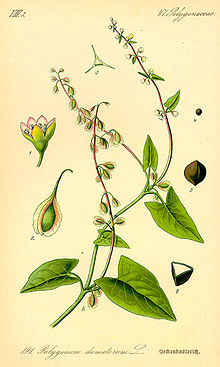Fallopia
| Fallopia | |
|---|---|
 |
|
| 1885 illustration | |
| Scientific classification | |
| Kingdom: | Plantae |
| (unranked): | Angiosperms |
| (unranked): | Eudicots |
| (unranked): | Core eudicots |
| Order: | Caryophyllales |
| Family: | Polygonaceae |
| Genus: |
Fallopia Adans. 1763 not Lour. 1790 |
| Type species | |
|
Polygonum scandens L. |
|
| Synonyms | |
|
Bilderdykia Dumortier |
|
Bilderdykia Dumortier
Fallopia is a genus of about 12–15 species of flowering plants in the buckwheat family, often included in a wider treatment of the related genus Polygonum in the past. The genus is native to temperate and subtropical regions of the Northern Hemisphere. The genus includes herbaceous perennial plants, herbaceous vines, and woody vines.
Several species are serious invasive weeds, notably Japanese knotweed in Europe and North America.
The genus is named after Italian botanist Gabriello Fallopio, or Fallopius, who was the superintendent of the botanical garden at Padua. He was also an acclaimed anatomist, being considered a founder of modern anatomy along with Vesalius and Eustachius.
Fallopia species are used as food plants by the larvae of some Lepidoptera species including Coleophora therinella (recorded on F. convolvulus).
Crosses between Japanese knotweed and giant knotweed have occurred where the two species grow in close proximity. The hybrid, Fallopia × bohemica (syn. Polygonum × bohemicum) is known as Bohemian knotweed.
Fallopia × conollyana (F. baldschuanica × F. japonica) is called railway-yard knotweed.
Many knotweed species, particularly Japanese knotweed, giant knotweed and Himalayan knotweed are considered noxious, invasive pests. Like many such weeds, Japanese knotweed was introduced from Japan first into the U.K., then into North America in the 19th century as an ornamental plant.
...
Wikipedia
